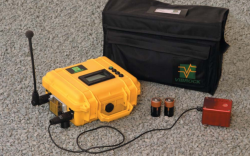What is Ground Vibration?
What is Ground Vibration and How Should it be Measured?
Ground Vibration can be caused by construction, equipment or blasting, etc. Seismographs can be used to measure and record ground vibration. It is measured in terms of Peak Particle Velocity (PPV) and the units are mm/s. PPV refers to the movement within the ground of molecular particles and not surface movement. Ground vibration on a building or structure should be measured outside the structure and at ground level. The displacement value in mm refers to the movement of particles at the surface.
 The mathematical formula for this is:
The mathematical formula for this is:
PPV = 2πfa
Π = 3.142
f = frequency in (cycles per second) Hz
a = displacement in mm
This formula is only true for sine waves.
What are the British Standards for Ground Vibration?
The British Standards which provide guidance for measurement are:
1) BS:7385 Evaluation & Measurement for Vibration in Buildings
- Part 1 – Guide for Measurement of Vibrations & Their Effects on Buildings
- Part 2 – Guide to Damage Levels from Ground-borne Vibration
2) BS:5228-2:2009+A1:2014 Code of Practice for Noise & Vibration Control on Construction and Open Sites – Part 2: Vibration
3) BS:6472 Evaluation of Human Exposure to Vibration in Buildings
BS:7385 and BS:5228 concern levels of vibration which may cause damage, whereas BS:6472 provides a guide for nuisance levels.
Why is it important to measure Ground Vibration?
There are a few reasons why it is important to measure vibration, including:
- ensuring that levels of vibration do not cause damage to neighbouring property
- to prevent annoyance to others by maintaining the lowest possible levels
- demonstrating compliance with conditions
-

Castle Products
CLICK HERE FOR
Information, technical data, images and pricing of all Castle Group Ltd. products -

Product Rental
CLICK HERE FOR
Hire the best equipment at a fraction of the purchase price -

Calibration Lab.
CLICK HERE FOR
Calibration and repair services from Air Samplers to Vibration Meters -

Training
CLICK HERE FOR
World class safety and environmental courses. On your site or our 4* training facility -

Consultancy
CLICK HERE FOR
Employ our expertise for both simple and more demanding issues.












